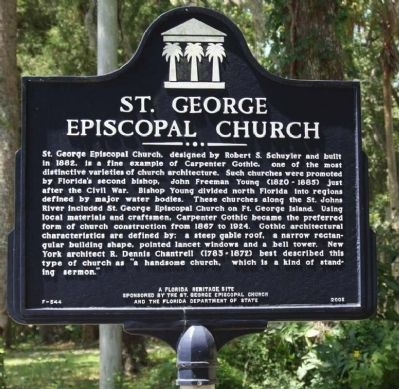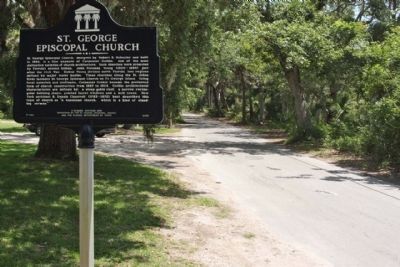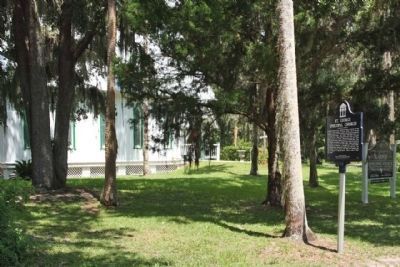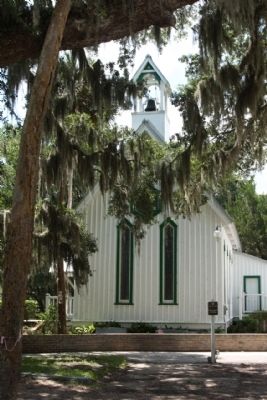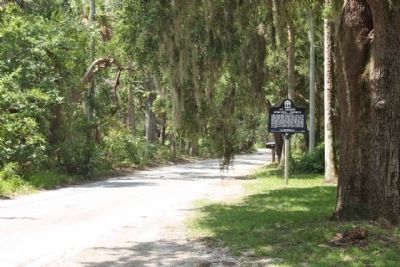Fort George Island in Duval County, Florida — The American South (South Atlantic)
St. George Episcopal Church
St. George Episcopal Church, designed by Robert S. Schuyler and built in 1882, is a fine example of Carpenter Gothic, one of the most distinctive varieties of church architecture. Such churches were promoted by Florida's second bishop, John Freeman Young (1820-1885) just after the Civil War. Bishop Young divided north Florida into regions defined by major water bodies. These churches along the St. Johns River included St. George Episcopal Church on Ft. George Island. Using local materials and craftsmen, Carpenter Gothic became the preferred form of church construction from 1867 to 1924. Gothic architectural characteristics are defined by: a steep gable roof, a narrow rectangular building shape, pointed lancet windows and a bell tower. New York architect R. Dennis Chantrell (1783-1872) best described this type of church as "a handsome church, which is a kind of standing sermon."
Erected 2005 by St. George Episcopal Church, and the Florida Department of State. (Marker Number F-544.)
Topics. This historical marker is listed in this topic list: Churches & Religion. A significant historical year for this entry is 1882.
Location. 30° 24.81′ N, 81° 25.76′ W. Marker is on Fort George Island , Florida, in Duval County. Marker is on Fort George Road, on the left when traveling north. Touch for map. Marker is at or near this postal address: 10560 Fort George Road, Jacksonville FL 32226, United States of America. Touch for directions.
Other nearby markers. At least 8 other markers are within 2 miles of this marker, measured as the crow flies. The Huguenot Memorial Site (approx. half a mile away); Jean Ribaut (approx. 0.8 miles away); Pilot Town/Napoleon Bonaparte Broward (approx. 0.8 miles away); Fort George Island (approx. one mile away); Site of the Mission of San Juan del Puerto (approx. one mile away); Ribault Club Inn (approx. one mile away); U.S. Merchant Marine (approx. 1.2 miles away); French Huguenots in North America (approx. 1.2 miles away). Touch for a list and map of all markers in Fort George Island.
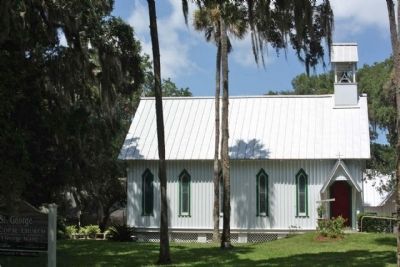
Photographed By Mike Stroud, July 10, 2012
4. St. George Episcopal Church seen from Fort George Road
St. George’s building remains essentially unchanged and has been recognized by the City of Jacksonville and the State of Florida as an historic building.
Church website homepage
Click for more information.
Church website homepage
Click for more information.
Credits. This page was last revised on March 21, 2023. It was originally submitted on September 1, 2012, by Mike Stroud of Bluffton, South Carolina. This page has been viewed 604 times since then and 50 times this year. Last updated on February 14, 2021, by Jason R. Surratt of Aurora, Colorado. Photos: 1, 2, 3, 4, 5, 6. submitted on September 2, 2012, by Mike Stroud of Bluffton, South Carolina. • J. Makali Bruton was the editor who published this page.
